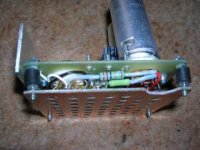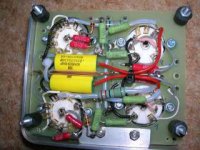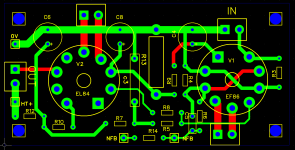Ian.
I'm sure you have this original build article:
Mullard 3-3. Three Watt Amplifier
It really is'nt worth doing a PCB for it, so I strongly doubt that anyone has.
Cheers,
Ian
I'm sure you have this original build article:
Mullard 3-3. Three Watt Amplifier
It really is'nt worth doing a PCB for it, so I strongly doubt that anyone has.
Cheers,
Ian
Ian,
Yes, I have the original article. I did Google for a PCB and found a homebrew one but no others. I want to build this into a 19 inch rack enclosure rather than a regular chassis. I was thinking of a pair on a single PCB with an external SS PSU. Wiring the heaters of both stages in series would allow its heaters be run from a 12V dc 1 amp dc supply.
I also read somewhere that there was a PCB version at some time so I would be interested in seeing the layout.
Cheers
Ian
Yes, I have the original article. I did Google for a PCB and found a homebrew one but no others. I want to build this into a 19 inch rack enclosure rather than a regular chassis. I was thinking of a pair on a single PCB with an external SS PSU. Wiring the heaters of both stages in series would allow its heaters be run from a 12V dc 1 amp dc supply.
I also read somewhere that there was a PCB version at some time so I would be interested in seeing the layout.
Cheers
Ian
Check out MabelAudio they may have something or something which can be made to work. It would not be a Mullard 3 + 3 (EF86 + EL84).
They certainly have a board for something similar but with EL34 outputs which could also be made to work with 6V6.
Mableaudio is a company who can build tube amplifier and we also supply all the components for tube amplifier.Such as tubes,tubes sockets,switches,capacitors,resistors,PCB,chassis to get you started_MABLE AUDIO
If you are prepared to go push pull (but still Class A)then there is this:
Untitled
6005 are 6AQ5'ish or 6V6 in small base.
THis list is now dated but may be worth browsing:
World Tube Audio Portal - Category Tube Amplifier Kits
Cheers,
Ian
They certainly have a board for something similar but with EL34 outputs which could also be made to work with 6V6.
Mableaudio is a company who can build tube amplifier and we also supply all the components for tube amplifier.Such as tubes,tubes sockets,switches,capacitors,resistors,PCB,chassis to get you started_MABLE AUDIO
If you are prepared to go push pull (but still Class A)then there is this:
Untitled
6005 are 6AQ5'ish or 6V6 in small base.
THis list is now dated but may be worth browsing:
World Tube Audio Portal - Category Tube Amplifier Kits
Cheers,
Ian
Is the homebrew version the one on UKVRR? The 3-3 is a simple design, as simple as it gets really; why not make your own from copper clad/ If your a member of UKVRR you could PM MM ( the OP of the 3-3 PCB thread) and I,m sure he,ll be happy to share his design.
If not if you can knock up a design on CAD or something similar, there are quite a few companies that will knock up a few PCB's for you.
Personally, I make my own simple PCB,s out of copper clad board using a Dremmel to remove the copper. If your not good/unable to use your hands PM me and I'll make one for you if you sort the design out.
Good luck,Andy.
If not if you can knock up a design on CAD or something similar, there are quite a few companies that will knock up a few PCB's for you.
Personally, I make my own simple PCB,s out of copper clad board using a Dremmel to remove the copper. If your not good/unable to use your hands PM me and I'll make one for you if you sort the design out.
Good luck,Andy.
Pictures of layout in first post of this link:
PCB based Mullard 3-3 - UK Vintage Radio Repair and Restoration Discussion Forum
Cheers
John
PCB based Mullard 3-3 - UK Vintage Radio Repair and Restoration Discussion Forum
Cheers
John
Is the homebrew version the one on UKVRR? The 3-3 is a simple design, as simple as it gets really; why not make your own from copper clad/ If your a member of UKVRR you could PM MM ( the OP of the 3-3 PCB thread) and I,m sure he,ll be happy to share his design.
If not if you can knock up a design on CAD or something similar, there are quite a few companies that will knock up a few PCB's for you.
Personally, I make my own simple PCB,s out of copper clad board using a Dremmel to remove the copper. If your not good/unable to use your hands PM me and I'll make one for you if you sort the design out.
Good luck,Andy.
Hi Andy,
I am quite happy to design my own PCB if necessary. I already do a lot of tube PCB designs. I wanted to avoid the "I'm going to design a Mullard 3-3 PCB layout" post only to be bombarded with a host of "it's already been done" posts.
Cheers
Ian
Pictures of layout in first post of this link:
PCB based Mullard 3-3 - UK Vintage Radio Repair and Restoration Discussion Forum
Cheers
John
Hi John,
When I said in my first post that my searches had only turned up one PCB, that was the one!
Cheers
Ian
This list is now dated but may be worth browsing:
World Tube Audio Portal - Category Tube Amplifier Kits
Cheers,
Ian
Hi Ian,
Thanks for the link. Although some of the links are broken that is a very useful resource.
Cheers
Ian
Ian,
I am just curious as to why you picked the 3-3 to build..
Is it the EF86 that has interested you?
Regards
M. Gregg
I design and build all tube audio mixers. I am very lucky to live in a three story house, the entire top floor of which is mine. In one room is my 24 track digitial/semiconductor project studio and the other room is my tube audio workshop. When I finish a mixer I cart it into the studio, connect it up and subject it to extensive listening tests. Before that, most of the testing is done in the workshop with my Lindos MS10 audio tester.
I have a couple of spare Tannoy Mercury bookshelf speakers so I thought it would be nice to be able to power them in my workshop with a simple tube amplifier so I could do some listening tests in there as well. I don't need any great power so a simple SE will do and the Tannoys are quite efficient. I like the 3-3 because of its innovative direct coupling which reduces the number of poles in the loop gain.
It is also an opportunity to try the EF86. All my current desings have the 12AX7 at the front but these can be quite microphonic and I generally use selected 12AX7WA types to minimise it. As the EF86 was designed for low microphonics it seemed like a good way to check it out.
Cheers
Ian
Perhaps
it might be interesting to try the RH EF86/EL84 just for fun..as a comparison.
http://rh-amps.blogspot.co.uk/2013/08/rh84-ppe-parallel-pentode-edition.html
Its about half way down the page..I mounted the EF86 and board on anti vibration mounts.
Regards
M. Gregg
it might be interesting to try the RH EF86/EL84 just for fun..as a comparison.
http://rh-amps.blogspot.co.uk/2013/08/rh84-ppe-parallel-pentode-edition.html
Its about half way down the page..I mounted the EF86 and board on anti vibration mounts.
Regards
M. Gregg
Last edited:
Just for interest,
I used the RH84 single tube with XSE-15-8-5K with a single tube.. the 7805 works well..
the 7805 works well..
I used a kimber Kap coupling capacitor between the stages and it works well..(I know it goes against the grain but it works well).
I like the EF86 front end. You can get the old Mcmurdo anti vibration mounts or mount the bottom half of the shield bases with rubber grommets.
https://www.google.co.uk/search?q=Mcmurdo+anti+vibration+valve+base&source=lnms&tbm=isch&sa=X&ei=_LKmU4XkI8TBPNKygKgG&ved=0CAYQ_AUoAQ&biw=1524&bih=696#facrc=_&imgdii=_&imgrc=cXQY1woD2oq4KM%253A%3BdNuGdAfi5d8RkM%3Bhttp%253A%252F%252Felectrojumble.org.uk%252FVH_B7G_AV.jpg%3Bhttp%253A%252F%252Felectrojumble.org.uk%252FValves_etc.htm%3B400%3B348
These are good for mounting boards..You can get them cheaper if you look around its just for info.
http://www.maplin.co.uk/p/mfa-anti-vibration-motor-mounts-n17bq?gclid=CKfA57Snjb8CFYIewwod_aIAWg
Another example..
http://www.mfacomodrills.com/gearbox_accessories/919D_accessories.html
I used RRR resistors they are quite cheap and work well..
Regards
M. Gregg
I used the RH84 single tube with XSE-15-8-5K with a single tube..
I used a kimber Kap coupling capacitor between the stages and it works well..(I know it goes against the grain but it works well).
I like the EF86 front end. You can get the old Mcmurdo anti vibration mounts or mount the bottom half of the shield bases with rubber grommets.
https://www.google.co.uk/search?q=Mcmurdo+anti+vibration+valve+base&source=lnms&tbm=isch&sa=X&ei=_LKmU4XkI8TBPNKygKgG&ved=0CAYQ_AUoAQ&biw=1524&bih=696#facrc=_&imgdii=_&imgrc=cXQY1woD2oq4KM%253A%3BdNuGdAfi5d8RkM%3Bhttp%253A%252F%252Felectrojumble.org.uk%252FVH_B7G_AV.jpg%3Bhttp%253A%252F%252Felectrojumble.org.uk%252FValves_etc.htm%3B400%3B348
These are good for mounting boards..You can get them cheaper if you look around its just for info.
http://www.maplin.co.uk/p/mfa-anti-vibration-motor-mounts-n17bq?gclid=CKfA57Snjb8CFYIewwod_aIAWg
Another example..
http://www.mfacomodrills.com/gearbox_accessories/919D_accessories.html
I used RRR resistors they are quite cheap and work well..
Regards
M. Gregg
Last edited:
Just a thought,
My experience with EF86 and high gain has not been good (reliability)..they are great at low to medium gain. If I were looking at high gain I would research old valve oscilloscope circuits.
NB I found in the RH the EF86 didn't work well with a shield fitted but just the screened base works well.
I didn't have the luxury of a PCB I was trying to compact the circuit..
A bit of an effort..
Regards
M. Gregg
My experience with EF86 and high gain has not been good (reliability)..they are great at low to medium gain. If I were looking at high gain I would research old valve oscilloscope circuits.
NB I found in the RH the EF86 didn't work well with a shield fitted but just the screened base works well.
I didn't have the luxury of a PCB I was trying to compact the circuit..
A bit of an effort..
Regards
M. Gregg
Attachments
My experience, albeit from 40 odd years ago, with EF86s used in tape replay amps was that they were noisier, more microphonic and less reliable than an ECC83 used in a later version of the same unit. I have sometimes wondered if the older and larger EF37A was better than the EF86 but I have no solid information on this.
Obviously use in a 3-3 is a less exacting application.
Obviously use in a 3-3 is a less exacting application.
My experience, albeit from 40 odd years ago, with EF86s used in tape replay amps was that they were noisier, more microphonic and less reliable than an ECC83 used in a later version of the same unit. I have sometimes wondered if the older and larger EF37A was better than the EF86 but I have no solid information on this.
Obviously use in a 3-3 is a less exacting application.
As it is a pentode, the EF86 is bound to be noisier than the ECC83, but in this application, noise should not be an issue. The EF86 is supposed to be designed for low microphony, but as I have found with the ECC83, just how microphonic depends very much on who actually made it.
What I like about the Mullard circuit is the direct coupling from the EF86 to the EL84 which eliminates ones of the poles from the loop response.
Cheers
Ian
What I like about the Mullard circuit is the direct coupling from the EF86 to the EL84 which eliminates ones of the poles from the loop response.
Cheers
Ian
Yes, I built a 3-3 nearly 50 years ago and it sounded very good even though I used only parts which were on hand, an EF36 and a KT61 with a modified HT supply using smaller caps and a choke. The transformer was so much oversize it had to be mounted seperately.
I like your idea of running the heaters off 12 volts, it always seemed an efficent scheme to me.
- Home
- Amplifiers
- Tubes / Valves
- Mullard 3-3 PCB


